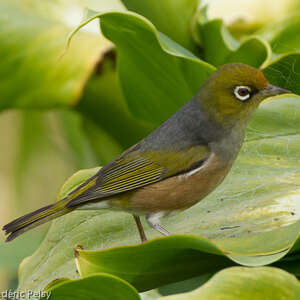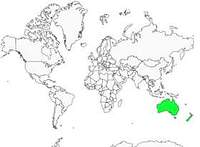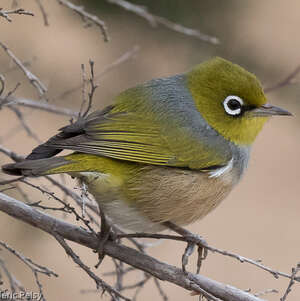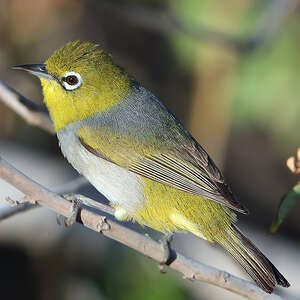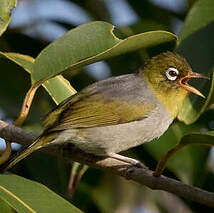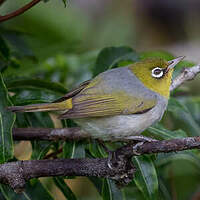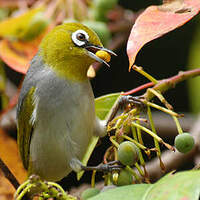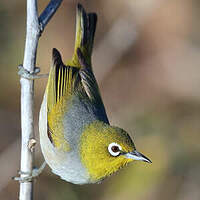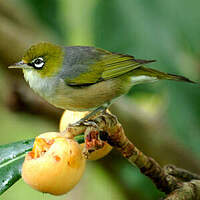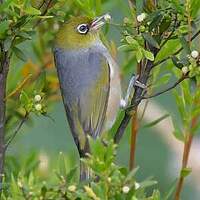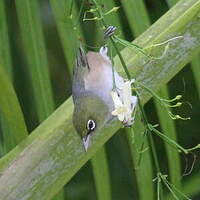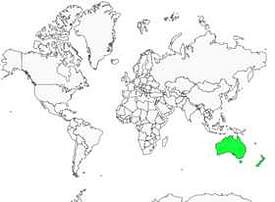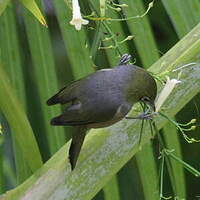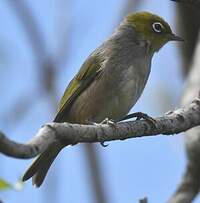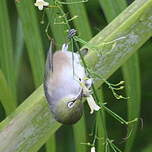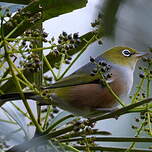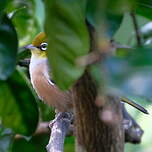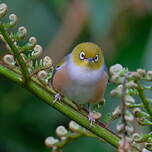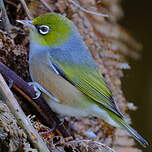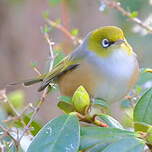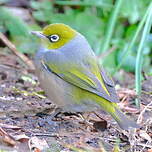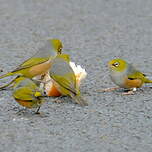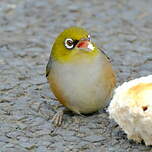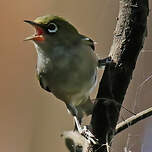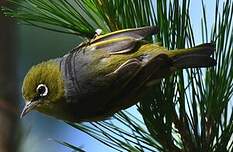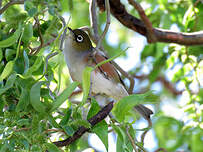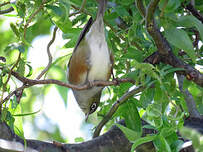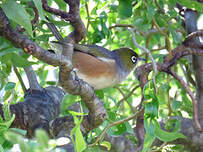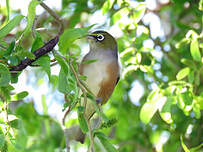Silvereye
Zosterops lateralis - Zostérops à dos gris
Identification
In Australia, three species of Silvereye can be found, with the Grey-backed Silvereye being the most widespread and easiest to see due to its white eye-ring. At least six subspecies of the bird are found on the continent, making it the only small olive-green and grey bird with white glasses. Its beak is thin, and its sub-tail, throat and flanks are yellow-brown depending on the subspecies, with its chest being greyish and its upper parts a darker olive-green. Males and females look the same, although juveniles lack the white eye-ring. In Cairns, it can be confused with the Yellow-bellied Silvereye (Zosterops luteus), which is noticeably smaller and has yellow undersides from beak to tail. The bird co-habits with other species in various archipelagos of the Indian Ocean.
Subspecific information 16 subspecies
- Zosterops lateralis lateralis (Norfolk and Flinders Is., Tasmania, New Zealand and Chatham Is.)
- Zosterops lateralis vegetus (Cape York Pen.. ne Australia.)
- Zosterops lateralis cornwalli (e Australia)
- Zosterops lateralis chlorocephalus (islands off e Australia)
- Zosterops lateralis westernensis (se Australia)
- Zosterops lateralis tephropleurus (Lord Howe I.. east of Australia.)
- Zosterops lateralis ochrochrous (King I.. w Bass Strait.)
- Zosterops lateralis pinarochrous (s to se Australia)
- Zosterops lateralis chloronotus (sw to s Australia)
- Zosterops lateralis griseonota (New Caledonia)
- Zosterops lateralis nigrescens (Loyalty Is.)
- Zosterops lateralis melanops (Lifou I.. c Loyalty Is..)
- Zosterops lateralis tropicus (nw and n Vanuatu)
- Zosterops lateralis vatensis (c and s Vanuatu)
- Zosterops lateralis valuensis (Mota Lava. ne Vanuatu.)
- Zosterops lateralis flaviceps (Fiji Is.)
Foreign names
- Zostérops à dos gris,
- Anteojitos dorsigrís,
- olho-branco-de-dorso-cinzento,
- Graumantel-Brillenvogel,
- ezüstös pápaszemesmadár,
- Grijsrugbrilvogel,
- Occhio d'argento,
- gråryggig glasögonfågel,
- Gråbrystbrillefugl,
- okánik pláštikový,
- kruhoočko australopacifické,
- Grårygget Brillefugl,
- hopearilli,
- zostèrops de dors gris,
- szlarnik rdzawoboczny,
- Серебряная белоглазка,
- ハイムネメジロ,
- 灰胸绣眼鸟,
- gråryggig glasögonfågel,
- 灰胸繡眼,
Voice song and call
Habitat
Behaviour character trait
Individuals living in tropical regions are at most erratic but more often sedentary. In contrast, the birds nesting in Tasmania (subspecies lateralis) are partially migratory and can undertake journeys of hundreds of kilometers that take them to southeastern Australia during the Australian winter.
The birds nesting in the South Island of New Zealand do the same but head towards the North Island. Couples remain together (for life?) even during winter within these groups. It is within these winter groups that the young from the same year pair up.Dietfeeding habits
Reproduction nesting
In New Zealand, reproduction extends from September to March, from September to January in Australia.
The nest is a cup of fine grasses, mosses and spider webs suspended in a bush. There are two or three clutches per year depending on the regions, sometimes up to five in tropical areas. The female lays two to four pale blue eggs which the two adults incubate for around ten days. The chicks stay in the nest for less than two weeks. The clutches are often parasitized by the Shining Cuckoo (Chrysococcyx lucidus).Geographic range
Silvereye has a wide distribution range extending from southern Australia, including Tasmania, to New Caledonia and Vanuatu, and even New Zealand. In eastern and southern Australia it is found in a large coastal area, ranging from the vicinity of Cairns to that of Perth. Its presence in multiple isolated islands and archipelagos explains the large number of recognized subspecies (16).
Threats - protection
Sources of information
- IOC World Bird List (v15.1), Gill, F and D Donsker (Eds). 2025-12-07.
- The Field Guide to the Birds of Australia, Graham Pizzey et Frank Knight
- The hand guide to the birds of New Zealand, Robertson Hugh et Heather Barrie
- Vol 13- Handbook of the birds of the world, del Hoyo J., Elliott A. Christie D.
- xeno-canto, Sharing bird sounds from around the world,
Other sources of interest
 Specification sheet created on
31/07/2023 by Georges Olioso
Specification sheet created on
31/07/2023 by Georges OliosoTranslation by AI Oiseaux.net
© 1996-2025 Oiseaux.net
- Accipitriformes
- Aegotheliformes
- Anseriformes
- Apodiformes
- Apterygiformes
- Bucerotiformes
- Caprimulgiformes
- Cariamiformes
- Casuariiformes
- Charadriiformes
- Ciconiiformes
- Coliiformes
- Columbiformes
- Coraciiformes
- Cuculiformes
- Eurypygiformes
- Falconiformes
- Galliformes
- Gaviiformes
- Gruiformes
- Leptosomiformes
- Mesitornithiformes
- Musophagiformes
- Nyctibiiformes
- Opisthocomiformes
- Otidiformes
- Passeriformes
- Pelecaniformes
- Phaethontiformes
- Phoenicopteriformes
- Piciformes
- Podargiformes
- Podicipediformes
- Procellariiformes
- Psittaciformes
- Pterocliformes
- Rheiformes
- Sphenisciformes
- Steatornithiformes
- Strigiformes
- Struthioniformes
- Suliformes
- Tinamiformes
- Trogoniformes

